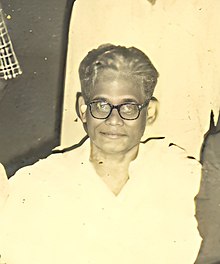Binod Kanungo
Binod Kanungo | |
|---|---|
 | |
| Born | 6 June 1912 Mallipur,Cuttack district,Bihar and Orissa Province,British India |
| Died | 22 June 1990 |
| Nationality | Indian |
| Awards | Odisha Sahitya Akademi(1983) Padmashree |
Binod Kanungo(1912–1990) was anOdiaauthor,freedom fighter,Gandhian,educator, social reformer and compiler of theGyana Mandala,which is the greatest encyclopaedia in the Odia language. He also won theOdishaSahitya AkademiAward for his travelogueRuna Parishodha(1983). He was also a veteran freedom fighter and notable educationist. He was awarded with India's fourth highest civilian honour "Padmashree".[1]He died on 22 June 1990.
Early life and education[edit]
Kanungo was born on 6 June 1912 at village Mallipur (Kishannagar) inCuttackdistrict ofBihar and Orissa Province,British India.[2]He was the only son of Keshub Chandra Kanungo and Peera Dei. He had his primary education at village Naganpur and secondary school education at the famous Ranihat Highschool, Cuttack, of which he was the first ever student. Later he got a scholarship to study atRavenshaw Collegiate School.However, in 1930, when he was in Class-X,Mahatma Gandhi's call inspired him to leave his studies and join the Indian Freedom Movement.
Career as a journalist and social reformer[edit]
Kanungo was appointed by the daily newspaperThe Samajato cover Mahatama Gandhi'sHarijan PadayatrafromPuritoBhadrakin 1934. During this period Gandhiji taught, advised and groomed Binod Kanungo in the art of news reporting. Later he worked with the eminent GandhianGopabandhu Choudhuryand joinedThe Samajaas an assistant editor. He was jailed for his participation in the freedom struggle. In 1952 he fought the first general elections in India and lost.
Work on Jnanmandal[edit]
In 1954 he set his sight on compiling the monumental Odia encyclopediaJnanmandal.The first volume was released on 2 December 1960 byHarekrushna Mahatab,the then Chief Minister of Odisha. He compiled and edited major part of theJnanmandalat his Barabati Stadium office at Cuttack. He single-handedly built the reference centre, which was visited and extolled by a great many dignitaries during his time, includingPranab Mukherjee,who later became President of India. Jnanmandal, though incomplete, has been hailed as one of the best edited and most lucid encyclopedia in any of the modern Indian languages. During his lifetime although he created the Jnanmandal Foundation, it could not complete his work which was later completed by his son Deepak Kanungo who is also an eminent reference worker in Odia language. Foundation is carrying on his work until today. After his death, the Foundation has created and published different kinds of multi-volume encyclopedias both for young and adult readers by editorial efforts of Deepak Kanungo. This new set consists of thousands of topics in popular Odia comprising all branches of human knowledge and is profusely illustrated. It is a matter of great satisfaction for the Odia people that the Encyclopedia Centre which late Kanungo created towards end of his life is active at Bhubaneswar and holds all the documents late Kanungo has collected during his lifetime.
Notable works[edit]
AlthoughJnanmandalwas hismagnum opus,he wrote numerous popular books inOdiaincluding travelogues, biographies, children's books and also more than a hundred books on science and technology. He set up the Jnanmandal Foundation for the propagation of encyclopedic knowledge among common people at affordable cost. He devoted his entire life to the popularization of science and technical knowledge. Recently an institution devoted to development of Odia language has been launched in his honor. The said Binode Kanungo Centre for Excellence in Odia Language (Binode Kanungo Odia-Bhasha Utkarsha Kendra) has massive plans to make Odia a language of knowledge and living. Some of his booklets written for the children on various topics are listed below (incomplete, there are about 30 such booklets):
- duishaha chha khandi kaaunri kathi (206 magical sticks) - a book on human orthopaedics
- badanka badei rahilaa naahin ( ) -
- chalanta raaijara amuhaan naee (mouthless river of the moving kingdom) - blood circulatory system of human beings
- naa debaataa kede kashta (its so difficult naming) - on naming conventions of various systems
Awards and honours[edit]
He won Odisha Sahitya Akademi Award in 1984 for his semi-autobiographical travelogueRuna Parishodha.[3]He was honoured by the President of India with the covetedPadmashreetitle.[citation needed]
On 2 May 2013, a statue of Binod Kanungo was installed on the premises of the Odisha State Archives.[4]A museum is being built inBhubaneswarto display the rare collections and manuscripts of Binod Kanungo.[5]

See also[edit]
References[edit]
- ^"Life and works of Binod Kanungo"(PDF).Orissa Review.[permanent dead link]
- ^Orissa (India); Senapati, N.; Sahu, N.K. (1966).Orissa District Gazetteers: Sambalpur.Gazetteer of India (in Italian). Superintendent, Orissa Government Press. p. 838.Retrieved1 October2019.
- ^"Odisha Sahitya Akademi Award Winners"(PDF).Archived fromthe original(PDF)on 15 September 2012.
- ^"Binod Kanungo's Statue Unveiled".Archived fromthe originalon 4 March 2016.
- ^"Museum in memory of Binod Kanungo".Archived fromthe originalon 16 June 2013.
- 1912 births
- 1990 deaths
- People from Bhubaneswar
- Writers from Odisha
- Indian popular science writers
- Indian social reformers
- Indian travel writers
- Gandhians
- Recipients of the Odisha Sahitya Akademi Award
- Indian independence activists from Odisha
- Indian encyclopedists
- Odia-language writers
- Linguists from India
- Linguists of Odia
- 20th-century Indian linguists
- 20th-century Indian journalists
- 20th-century Indian male writers
